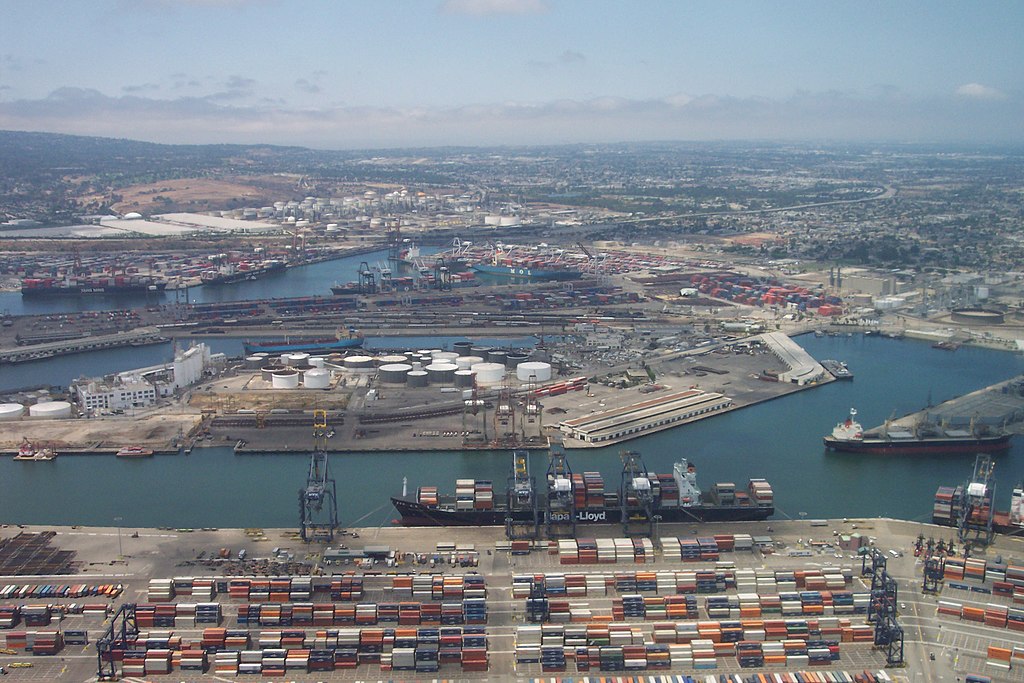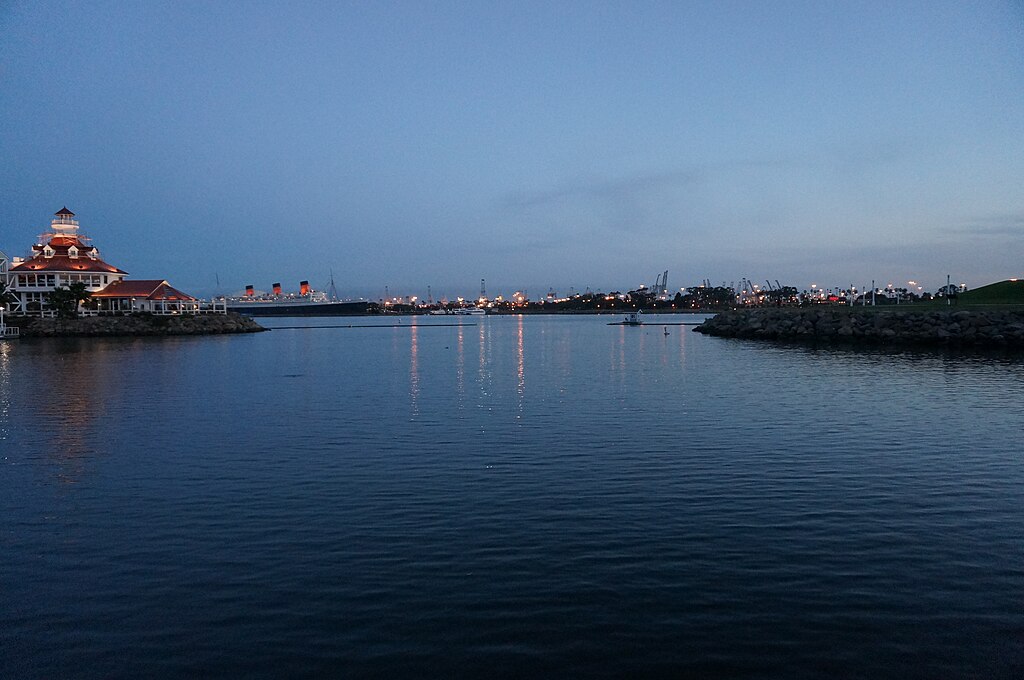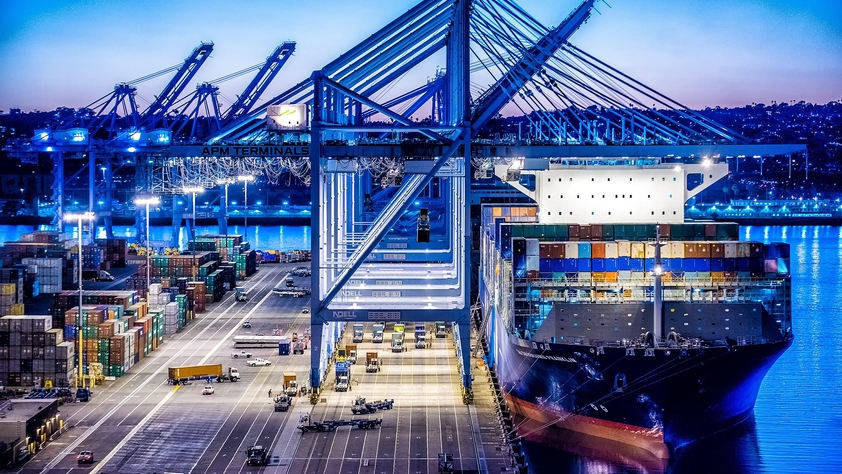Featured image credit: NickCPrior
Back in September, we highlighted some of the big changes coming for the Queen Mary Hotel in Long Beach, as well as the Port of Los Angeles as a whole. But with the 117-year-old port now boasting its second most active year of all time, those plans are taking more definitive shape. At a recent press conference, Port of Los Angeles executive director Gene Seroka detailed how the Western hemisphere’s busiest port plans to invest heavily in technology and real estate renovations to reach new heights of revenue generation and eco-friendliness simultaneously.
The Second Biggest Year on Record for the Port of Los Angeles

So what does the second biggest year in the Port of Los Angeles’s history look like? Well, 2024 closed with the largest year-over-year gain that the bustling port has recorded. It clocked in at 20% over 2023’s numbers, having transported over 10.3 million shipping containers. Ports tend to use the twenty-foot equivalent unit (TEU) as their standard method of container measurement. With that in mind, the Port of Los Angeles averaged 900,000 TEUs per month in 2024 with a surge in December to 921,616 TEUs (roughly a 24% increase).
The reasons for the port’s robust year are various, ranging from efficient use of data, a booming import/export trade year, and building economic strength. But more immediately, investments from the Union Pacific and BNSF railroad lines allowed the Port of Los Angeles to put $73 million behind its ambitious Pier 400 On-Dock rail line expansion.
And that’s just the beginning. They plan to continue the rail expansion to Fenix Marine Pier 300, allowing greater logistical efficiency. Speaking of logistics, the installation of a new digital platform allowing port-employed truck drivers to digitally update ETAs to waiting terminals has had a noticeably positive impact on workflow. Almost 20,000 truckers have been given clearance to use this innovative platform.
Cruising Toward a More Lucrative Future

But with business booming on the freight side, Seroka has revealed that development plans are largely turning toward the Port of Los Angeles’s tourist industry. A major facet of this plan is boosting the port’s ability to host cruise ships. Currently, the port anticipates receiving over 1.5 million cruise ship passengers in 2025. With each cruise ship promising around $1 million in local revenue, the port aims to allow a greater number of cruise ships to dock at its terminals each year.
Developers are focusing their efforts on the Outer Harbor Cruise Terminal with a goal of full development by 2030. These upgrades will allow the Port of Los Angeles to accept stops from some of the biggest cruise lines in the industry including Royal Caribbean and Princess. Designers are developing these updates to pivot to alternative uses in the cruise off-season including trade shows, conferences, and filming locations.
Capitalizing on Growing Tourism
Of course, the tourists docking at the Port of Los Angeles will need places to spend their money. And as our blog on the Queen Mary upgrades highlighted last September, those options are currently lacking. While the iconic Queen Mary is undergoing its own upgrades, the Port of Los Angeles is also expanding its waterfront retail area to offer a more robust tourist experience for docking cruise ship passengers.

It’s all part of a $250 million West Harbor expansion that will construct thousands of square feet of mixed-use commercial space including shopping, dining, and entertainment. Stand-out features include a 150-foot Ferris wheel and a 6,200-seat amphitheater. The latter will be managed by live theater and music venue operator Nederlander Organization in conjunction with a division of Hollywood’s Yamashiro restaurant. Organizers intend the waterfront retail expansion to open in segments with the first phase slated for 2026.
The Zero Emissions Future of the Port of Los Angeles
But the Port of Los Angeles is also taking this moment of good fortune to reinforce their commitment to a zero emissions future. In 2024, despite its second busiest year on record, the port dropped its emission levels to their lowest numbers since 2005. Not content to rest on their laurels, they are now set on achieving a zero-emissions rating by employing a series of projects. Working directly with the Los Angeles Department of Water and Power, the port is developing a program that will allow them to exchange diesel-powered equipment for more eco-conscious electric and hydrogen-powered dock equipment.
The $500 million initiative will also allow the installation of an improved charging infrastructure for its electric trucks and equipment, plus allow for expanded clean shore power operations. Plans are also underway to introduce an electric rail system for improved efficiency within the port. Finally, the Port of Los Angeles will lead the charge in coordinating green shipping corridors with other ports internationally. This will emphasize decarbonizing the vessels that the port serves.

The Path Forward is Anything But Clear
The port’s upward trajectory is expected to meet with some adversity as the Trump administration plans to aggressively introduce tariffs and trade restrictions. But the second-best year on record for the Port of Los Angeles came amidst a year of supply chain disruptions, labor shortages, and tariff battles that specifically targeted the shipping industry. Inertia remains on the port’s side as we go into 2025.

Comments
Post a Comment